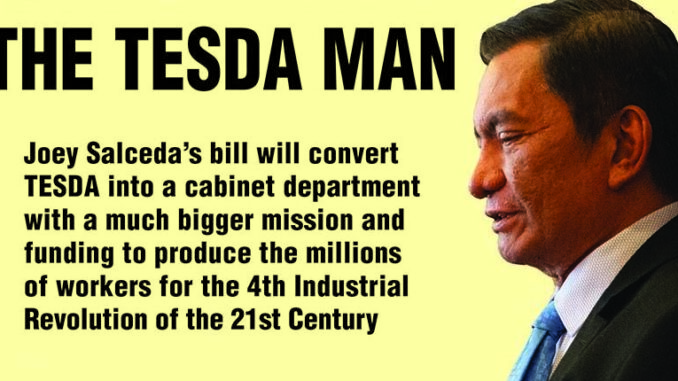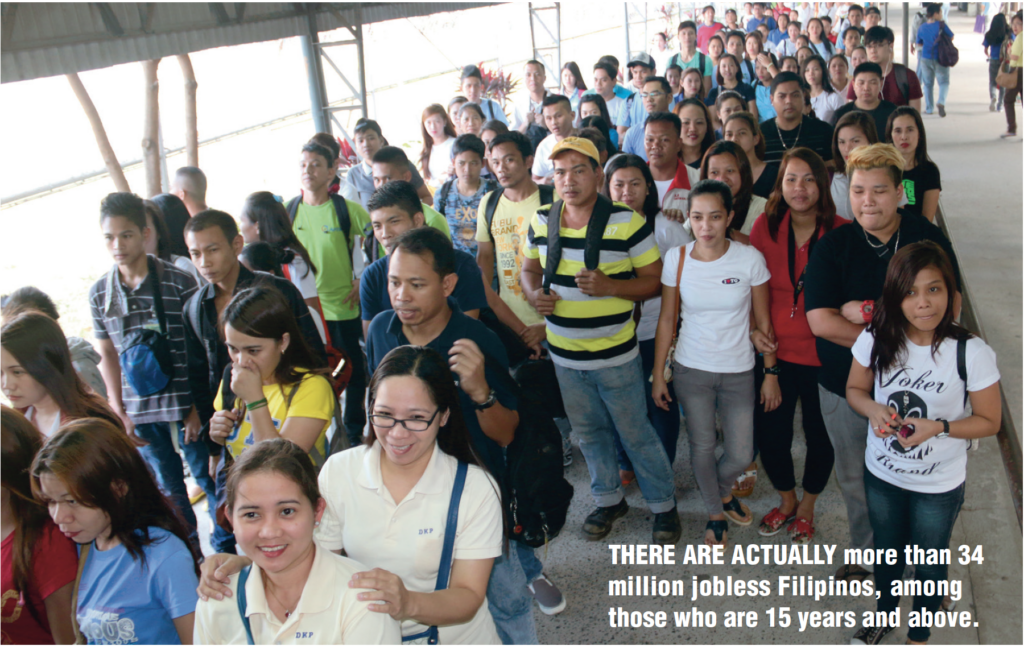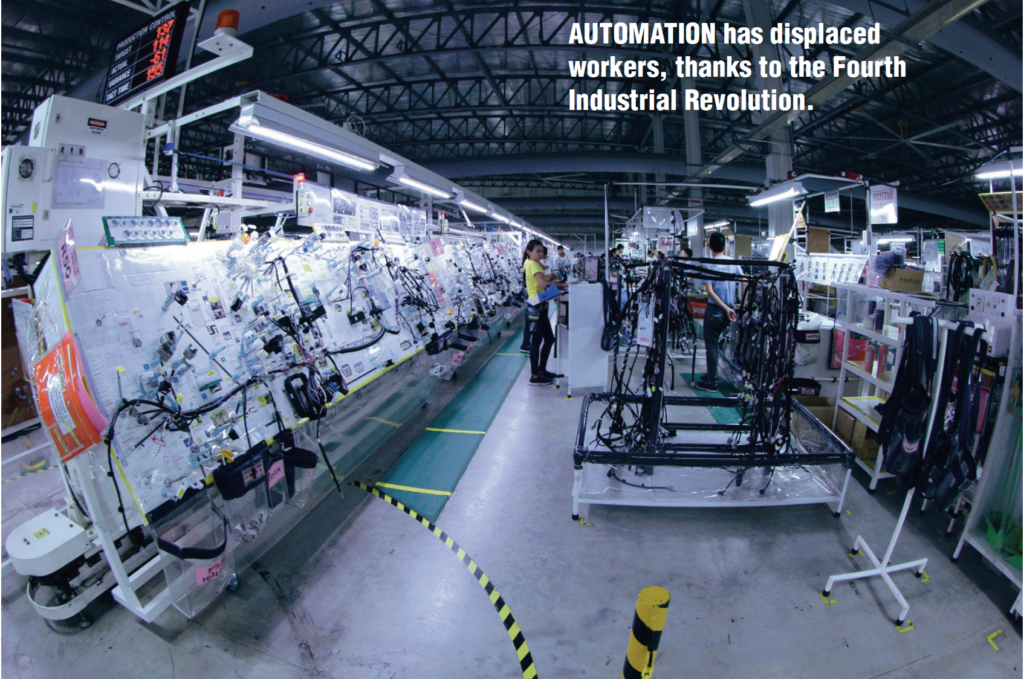
Salceda bill will transform 50M Filipino workers to get jobs under the Fourth Industrial Revolution
Among elected public officials in the Philippines, none has embraced the concept of TESDA and executed its vision with skill, enthusiasm, passion and excellence than Rep. Joey Sarte Salceda of Albay province’s second district.
TESDA, the Technical Education and Skills Development Authority, was established through the enactment of Republic Act No. 7796, the “Technical Education and Skills Development Act of 1994”, signed into law by President Fidel V. Ramos on Aug. 25, 1994.
RA 7796 aims to encourage the full participation of and mobilize the industry, labor, local government units and technical-vocational institutions in the skills development of the country’s human resources.
After 27 years, Salceda believes it’s time for a TESDA reset to enhance the agency’s relevance, produce more skilled workers than it does now, and prepare the Philippines to meet head on the challenges of the pandemic and the Fourth Industrial Revolution.
Primarily, Salceda wants TESDA elevated into a cabinet-level agency, expand its budget and reach out to and train more workers.
50 million workers will benefit
A Department of Technical Education and Skills Development (DTESD) could potentially benefit up to 50.54 million Filipino workers, 34 million of whom are currently jobless.
The 50.45 million include the more than 3.8 million jobless as of October 2020, most of them because of COVID-19; 31 million who are under-employed or those who are overqualified for their present job; and more than 15 million jobless but yet are not reckoned to be part of the labor force (defined as anyone above 15) simply because they are not looking for a job.
PH has 74 million pool of workers
Some 74.3 million Filipinos are 15 years or older. Yet, only 58.7% of them or 43.62 million are considered part of the labor force, leaving out 30.68 million potential workers but are jobless.
They are not counted as part of the labor force because they are not looking for a job. Such people include housewives and the uneducated or half-educated young who have stopped looking for a job out of frustration.
Of the 43.62 million labor force, 8.7% or 3.8 million are considered unemployed.

34.5 million Filipinos are actually jobless
If you add 30.68 million not counted as part of the labor force and the 3.8 million officially declared unemployed, total realistic unemployment could be 34.48 million or 46.4% of the 74.3 million population who are 15 and above and should be employable.
Conversion of TESDA into a cabinet department is part of what the Albay congressman calls his Comprehensive Education Reform Agenda (CERA). CERA seeks to open educational opportunities to the uneducated and the unskilled as well as to the miseducated so that they can have the mind, mindset, and skills needed by 21st Century industries brought about by the Fourth Industrial Revolution (the Fourth IR).
The Fourth IR builds on the digital revolution which is transforming entire systems of production, management, and governance. It builds on the Third IR, the digital revolution, and fuses technologies in nearly every field—the Internet of Things (IOT), artificial intelligence (AI), autonomous vehicles, 3-D printing, nanotechnology, biotechnology, materials science, energy storage and quantum computing.

Workers displaced by robots and AI
The Fourth IR has disrupted labor markets as robots, AI, and machines take over the jobs used to be held by humans. This could mean massive unemployment and its dire consequences.
But it could also mean wonderful job opportunities for those who have prepared for the Fourth IR. A TESDA reboot should do that preparation.
Already, per surveys, the digital economy has identified these 10 leading jobs: 1) robotics engineer; 2) cybersecurity specialist; 3) customer success specialist; 4) data scientist; 5) sales development representative; 6) full stack engineer; 7) development operations engineer; 8) data engineer; 9) java script developer; and 10) cloud engineer.Filipinos are ill-prepared to capture those jobs. The main reason is that the educational system itself is ill-prepared to prepare workers for future jobs of the Fourth IR.
Filipinos do poorly in reading, science and math
Filipino students consistently rank in the lowest rung or bracket of participants in tests for math, science, reading, and even writing.
In international competitions among students in math, science and reading, the Philippines is routinely beaten by the Thais, Indonesians, the Vietnamese, and of course, by the Malaysians.
Among Grade 4 students from 58 countries tested through TIMSS (Trends in International Mathematics and Science Study), Filipino students ranked exactly last.
In the PISA ranking of 76 countries, in 2018, the Philippines also languished in the last rung, in terms of reading, math, and science capability.
In the 10-member ASEAN, the Philippines has the highest unemployment rate—8.7%—or nearly five million workers out of work.
Unemployment was highest at 17.7% (or 7.3 million jobless) in April 2020, when nearly every enterprise was locked down. President Duterte almost solved unemployment, with the rate hitting a record low of 4.6% in 2019. But then COVID-19 struck.
Gradual reopening of the economy has reduced joblessness somehow. But four million workers denied work thru no fault of their own is unmanageable and unimaginable.
Quality education for all
Salceda’s answer to the crisis: CERA. He calls it quality education for all.
“COVID-19 and the emergence of the new economy have brought to the fore the weaknesses of a labor force not built to be competitive in a skills-based, digitally-based economy,” Salceda observes wryly. The high unemployment, he points out, “demonstrates how fragile the country’s job gains were – primarily in low-skill service sector jobs driven by our consumption-based economy.”
In a paper, Salceda notes:
“Even with recovery in the manufacturing sector during the succeeding quarters, high unemployment persisted to 9.96% in the third quarter, before settling at the latest 8.73%, still more than 64% higher than the first quarter figures. Agriculture was the most resilient economic sector during the quarantine, but challenges to the sector continue to bog down income levels among laborers in the sector.”
COVID-19 worsens employment gap
“COVID-19 has accelerated what could become a national employment gap. As the global economy has realized just how unimportant to many value-chains brick-and-mortar venues are, service sector jobs (such as janitorial services, security, storekeepers, etc.) that were shed during the pandemic may no longer return even once the “old normal” resumes. In their stead, high-skill jobs in the digital economy may be more in demand. Some signs of this shift were apparent even during the lockdowns. Among most industry sectors, only the business process outsourcing (BPO) industry remained in expansion mode.”
Opportunities
Still, Salceda is optimistic. He sees opportunities from the dismal panorama of utter joblessness. “The Philippines has the world’s largest concentration of call center workers. There is plenty of room for growth, but the industry has been hampered by the lack of a reliable supply of well-trained talent,” says the Albay solon, an economist and a top-rate anaylyst before his foray into politics.
The IT and Business Process Association of the Philippines has tried to attract more highly skilled work. “But just 15% of the BPO workforce were employed in such roles before the pandemic,” Salceda laments.
Incongruity
This has given rise to a sad irony. “There are few jobs left for the unskilled, while there are few workers eligible for available skilled work,” winces Salceda. “We are ill-prepared for value-adding work in a globalizing and digitalizing economy.” He is sad that “little of our labor force is employed in “21st century jobs” that require hard and soft skills.”
“Craft and related trades workers, while growing, are only at 6.4% of the workforce. We are a country with more ‘managers’ (at 9.3%) than skilled workers. More than a quarter of our labor force is in ‘elementary occupations’, or work that requires a lower level of skills. This means Filipino workers are very vulnerable. “With mobility restrictions, and with the rapid development of the virtual space as an alternative avenue for work, those in elementary occupations (such as janitors and others in occupations requiring physical presence in the workplace) were among the first to be rendered temporarily unemployed,” notes Salceda.
Even the local BPO industry is experiencing a skills shortage that is threatening its competitiveness, he points out. In Duterte’s P800-billion a year Build, Build, Build, the ambitious program is hampered by a severe lack of construction workers. One million are needed.
Education part of the Salceda DNA
Education is part of the Salceda DNA and brand of public service. Joey’s mother, Cielo Florin Sarte, was an elementary school teacher for 43 years. His father, Jesus Saguido Salceda, was a public high school teacher for 15 years, before Papa went into politics –26 years councilor, one term as vice mayor, and nine years as mayor. Salceda himself comes from a family of scholars and geniuses.
Addressing the challenges of Fourth IR
In his explanatory note to his House Bill seeking to elevate TESDA into a cabinet department, Salceda said to meet world standards “TESDA must address the need for modern facilities and equipment to level with the requirements in addressing the challenges created by the 4IR (Fourth Industrial Revolution) and other advancements that may happen in the future. It must also be bestowed with the police powers to impose sanctions and penalties to erring TESD implementers. These are among the limitations to what TESDA can do which can be ultimately addressed if the agency will be elevated into a line department of the government.”
Salceda concedes that in the past 27 years, TESDA “paved the way in providing millions of Filipnos with relevant, accessible, high quality and efficient technical education and skills development in support of the development of high quality Filipino middle-level manpower responsive to the country’s development goals and priorities. In 2018 alone, more than two million benefitted in the agency’s various Technical and Vocational Education and Training (TVET) program.”
But today, TESDA faces enormous challenges brought about by an inept educational system, the inadequate focus on vocational and technical education, the disruption of the Fourth IR, and the ongoing global pandemic which last year rendered jobless 70% of Filipino workers.
Easily a third of those workers can no longer return to work. Their jobs no longer exist. And their skills are no longer needed.
A more powerful TESDA
Salceda envisions a more powerful TESDA. “It must also be bestowed with the police powers to impose sanctions and penalties to erring TESD implementers,” he argues.
“These are among the limitations to what TESDA can do which can be ultimately addressed if the agency will be elevated into a line Department of the government.”
The Salceda Bill seeks to repeal R.A. 7796 or the TESDA Act of 1994 and to reinforce the powers and organizational function of TESDA by turning it into a Department.
The proposed Department of Technical Education and Skills Development shall become the primary policy formulation, planning, coordinating, implementing, regulating and administrative entity of the government for technical education and training and certification policies, plans and programs. It shall be headed by a secretary, four undersecretaries and four assistant secretaries.
Salceda believes his measure will strengthen as an implementing and regulatory institution of the Technical and Vocational Sector of the country’s trifocal education system.
“This measure is made in the interest of the Filipinos who wants to regain new skills and improve their well-being, and will be achieved in greater capacity vision as the transformational leader in the technical education and skills development of the Filipino workforce,” he declares.
What TESDA is supposed to do
In concept, TESDA is mandated to:
1. Integrate, coordinate and monitor skills development programs;
2. Restructure efforts to promote and develop middle-level manpower;
3. Approve skills standards and tests;
4. Develop an accreditation system for institutions involved in middle-level manpower development;
5. Fund programs and projects for technical education and skills development; and
6. Assist trainers training programs.

